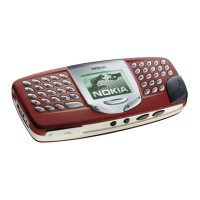NPM-5
UI Module Troubleshooting PAMS Technical Documentation
3DJH 1RNLD&RUSRUDWLRQ ,VVXH
voltages,” on page 73)
• Check pull-down resistors R701, R703, R704, R705, and network resistor
R702.
• Check presence of clock frequency 32.768kHz @ U301-Pin9 using oscillo-
scope (Figure 47, “MCU Clock Waveform – 32.768kHz,” on page 74).
• Check PURX @U301-Pin58 = 2.8V
0XVLF3OD\HU)XQFWLRQ
7KHVHPDLQGHYLFHVDUHWREHLQJRRGFRQGLWLRQIRUWKHPXVLFSOD\HUWRIXQFWLRQSURSHUO\
• U301 MCU
• U101 DSP
• U201 NAND Memory
• U601 Audio Codec
,WLVDVVXPHWKHXVHUKDVDYDOLGPXVLFILOHLQWKH1$1'PHPRU\
Diagnostic Tests:
• Check the stereo headset has proper contact with the UI module.
• Check present of VBAT, VBB and UC_VCC, DVCC, AVCC, CVCC (Appendix
A Table 2)
• Check operating current during play mode (Table 8, “UI current consumption in
normal conditons,” on page 73).
• Check present of clock frequency 32.768kHz @ U301-Pin9 using oscilloscope
(Figure 47, “MCU Clock Waveform – 32.768kHz,” on page 74).
• Check present of clock frequency 11.9952MHz @ U101-Pin97 and U601-
Pin25 (Figure 48, “DSP Clock Waveform – 11.9952MHz,” on page 75).
• Connect Stereo headset and check signal line ST_DET @ U301-Pin20
(Figure 9, “Accessories connection indication,” on page 73)
• Check for digital activities @ U601-Pin4 using oscilloscope. This check will
verify that the DSP are sending music information to the Codec.
• Check for analog activities @ U601-Pin9 and U601-Pin10 using oscilloscope.
This check will verify that the Codec decode the digital music information cor-
rectly.
/LQH,Q5HFRUGLQJ)XQFWLRQ
/LQH,QUHFRUGLQJDOORZVWKHXVHUWRUHFRUGH[WHUQDOPXVLF7KHVHPDLQGHYLFHVDUHWREH

